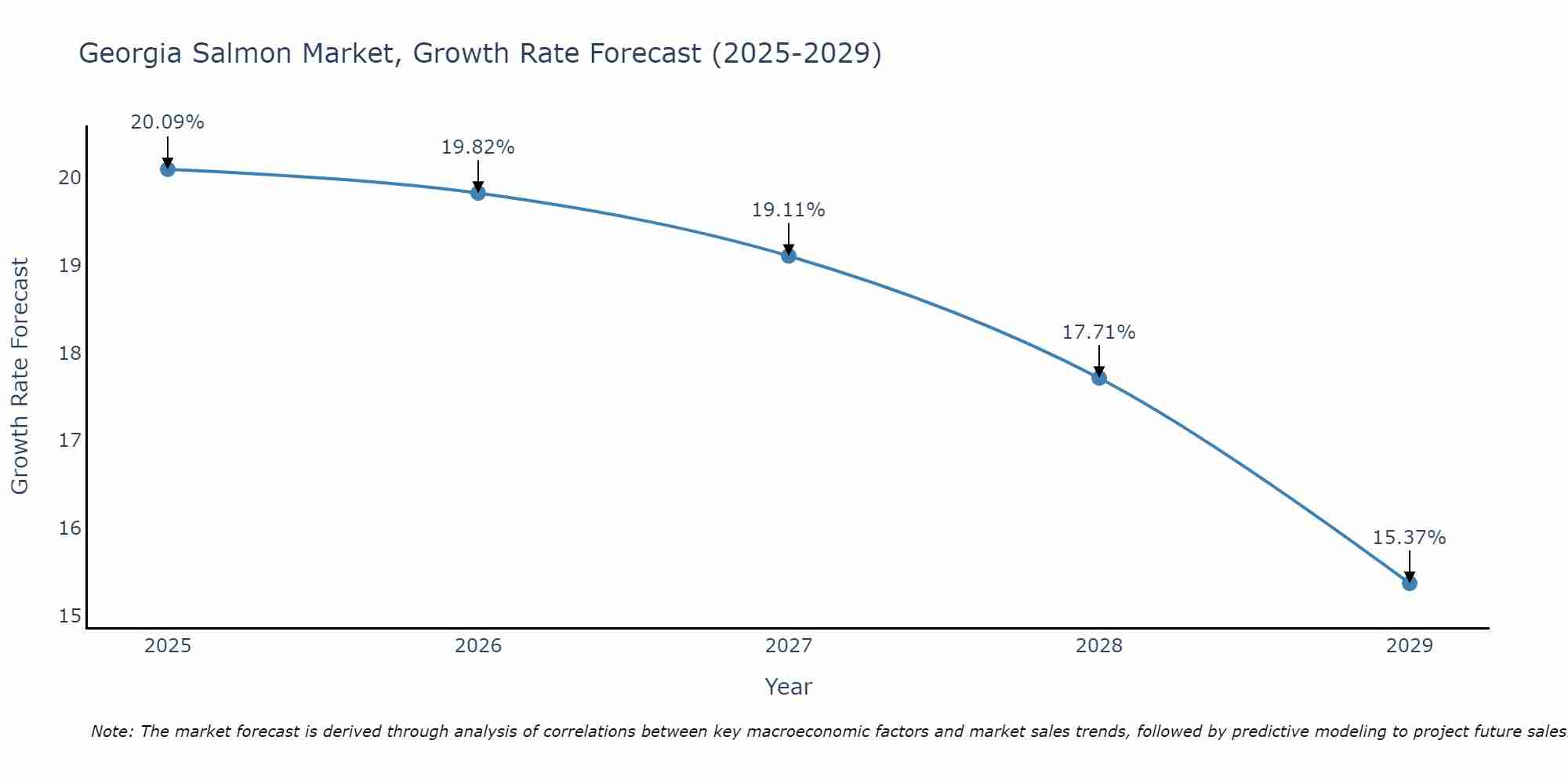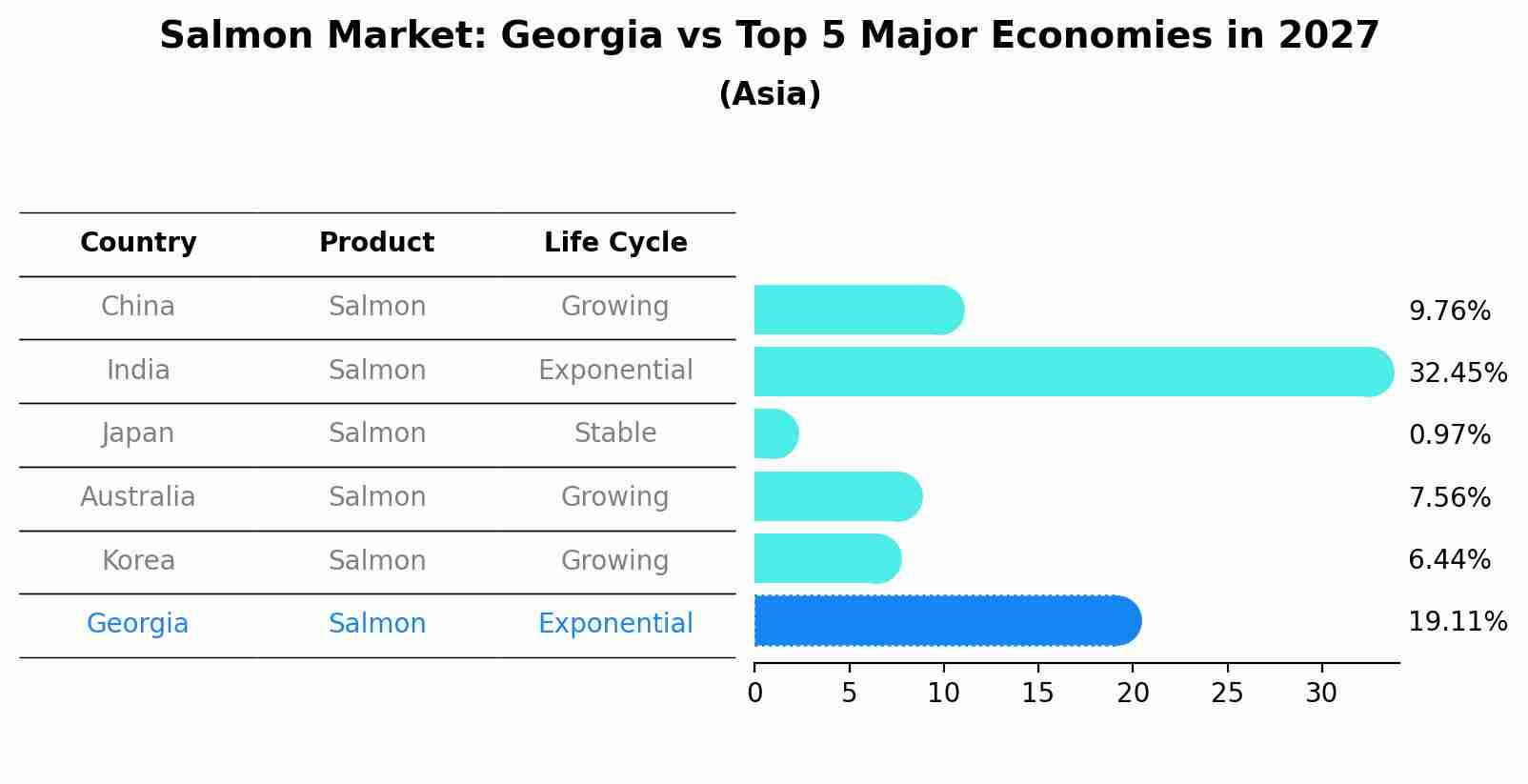Georgia Salmon Market (2025-2031) Outlook | Growth, Revenue, Analysis, Forecast, Size, Companies, Trends, Share, Value & Industry
| Product Code: ETC387660 | Publication Date: Aug 2022 | Updated Date: Jul 2025 | Product Type: Market Research Report | |
| Publisher: 6Wresearch | Author: Shubham Padhi | No. of Pages: 75 | No. of Figures: 35 | No. of Tables: 20 |
Georgia Salmon Market Size Growth Rate
The Georgia Salmon Market may undergo a gradual slowdown in growth rates between 2025 and 2029. Beginning strongly at 20.09% in 2025, growth softens to 15.37% in 2029.

Salmon Market: Georgia vs Top 5 Major Economies in 2027 (Asia)
Georgia's Salmon market is anticipated to experience a exponential growth rate of 19.11% by 2027, reflecting trends observed in the largest economy China, followed by India, Japan, Australia and South Korea.

Georgia Salmon Market Synopsis
The Georgia Salmon Market is a growing sector within the state`s seafood industry, driven by the increasing consumer demand for high-quality salmon products. With the rise of health-conscious consumers seeking nutritious food options, salmon has become a popular choice due to its rich omega-3 fatty acids and protein content. Georgia`s proximity to major transportation routes allows for efficient distribution of fresh and frozen salmon products, catering to both retail and foodservice sectors. Local salmon farms and seafood suppliers play a key role in meeting the demand for fresh, sustainable salmon in the region. The market is also influenced by global salmon trends, pricing fluctuations, and environmental sustainability concerns, prompting industry players to adapt and innovate to stay competitive in this dynamic market landscape.
Georgia Salmon Market Trends
The Georgia Salmon Market is currently experiencing a surge in demand for sustainable and locally sourced salmon. Consumers are increasingly seeking out wild-caught and sustainably farmed salmon due to growing concerns about environmental impact and food safety. Additionally, there is a rising trend towards value-added salmon products such as smoked salmon, salmon burgers, and salmon jerky, catering to consumers looking for convenient and healthy meal options. The market is also witnessing a shift towards online sales and direct-to-consumer channels as a result of the COVID-19 pandemic, with more consumers opting to purchase salmon products online for convenience and safety. Overall, the Georgia Salmon Market is evolving to meet the changing preferences and priorities of consumers, emphasizing sustainability, quality, and convenience.
Georgia Salmon Market Challenges
In the Georgia Salmon Market, one of the key challenges faced is the competition from other salmon-producing regions such as Norway and Chile, which have established strong reputations for high-quality salmon. This competition puts pressure on Georgia salmon producers to differentiate themselves through sustainable practices, traceability, and product quality to remain competitive in the market. Additionally, issues related to regulations and compliance, environmental sustainability, and changing consumer preferences towards wild-caught salmon versus farmed salmon also pose challenges for the Georgia Salmon Market. To address these challenges, market players in Georgia need to invest in innovation, technology, and marketing strategies to enhance their market position and meet the evolving demands of consumers in the seafood industry.
Georgia Salmon Market Investment Opportunities
Investment opportunities in the Georgia Salmon Market include potential for growth in salmon farming operations to meet the increasing demand for seafood consumption. With Georgia`s strategic location and ample water resources, there is room for expansion in aquaculture facilities to produce high-quality salmon for local and export markets. Additionally, advancements in sustainable farming practices and technology offer opportunities for investors to support environmentally friendly salmon production methods, which are increasingly favored by consumers. Collaborating with local fish farmers, investing in processing and distribution infrastructure, or exploring partnerships with seafood retailers could all present promising avenues for investment in the dynamic and growing Georgia Salmon Market.
Jordan Agar Market Government Policies
The government policies related to the Georgia Salmon Market primarily focus on regulations to ensure sustainable fishing practices and the protection of the natural environment. The Georgia Department of Natural Resources implements strict quotas and monitoring measures to prevent overfishing and maintain the health of salmon populations. Additionally, there are regulations in place to control pollution and habitat destruction in salmon breeding areas. The government also provides support and incentives for aquaculture businesses to promote the growth of the salmon industry in Georgia. Overall, the policies aim to strike a balance between economic development and conservation efforts to sustain the salmon market in Georgia for future generations.
Georgia Salmon Market Future Outlook
The future outlook for the Georgia Salmon Market appears to be positive, driven by increasing consumer demand for healthy and sustainable seafood options. With a growing focus on health and wellness, salmon`s reputation as a nutritious protein source rich in omega-3 fatty acids positions it well to continue gaining popularity among consumers. Additionally, advancements in aquaculture technology and practices are expected to improve efficiency and sustainability in salmon farming, potentially increasing production and driving down prices. As long as environmental concerns are addressed and consumer preferences for high-quality, responsibly sourced salmon are met, the Georgia Salmon Market is poised for growth in the coming years.
Key Highlights of the Report:
- Georgia Salmon Market Outlook
- Market Size of Georgia Salmon Market, 2024
- Forecast of Georgia Salmon Market, 2031
- Historical Data and Forecast of Georgia Salmon Revenues & Volume for the Period 2021 - 2031
- Georgia Salmon Market Trend Evolution
- Georgia Salmon Market Drivers and Challenges
- Georgia Salmon Price Trends
- Georgia Salmon Porter's Five Forces
- Georgia Salmon Industry Life Cycle
- Historical Data and Forecast of Georgia Salmon Market Revenues & Volume By Type for the Period 2021 - 2031
- Historical Data and Forecast of Georgia Salmon Market Revenues & Volume By Chinook Salmon for the Period 2021 - 2031
- Historical Data and Forecast of Georgia Salmon Market Revenues & Volume By Coho Salmon for the Period 2021 - 2031
- Historical Data and Forecast of Georgia Salmon Market Revenues & Volume By Pink Salmon for the Period 2021 - 2031
- Historical Data and Forecast of Georgia Salmon Market Revenues & Volume By Red Salmon for the Period 2021 - 2031
- Historical Data and Forecast of Georgia Salmon Market Revenues & Volume By Salmo Salar for the Period 2021 - 2031
- Historical Data and Forecast of Georgia Salmon Market Revenues & Volume By Silverbrite Salmon for the Period 2021 - 2031
- Historical Data and Forecast of Georgia Salmon Market Revenues & Volume By End Product Type for the Period 2021 - 2031
- Historical Data and Forecast of Georgia Salmon Market Revenues & Volume By Fresh for the Period 2021 - 2031
- Historical Data and Forecast of Georgia Salmon Market Revenues & Volume By Frozen for the Period 2021 - 2031
- Historical Data and Forecast of Georgia Salmon Market Revenues & Volume By Canned for the Period 2021 - 2031
- Historical Data and Forecast of Georgia Salmon Market Revenues & Volume By Others for the Period 2021 - 2031
- Historical Data and Forecast of Georgia Salmon Market Revenues & Volume By Distribution Channel for the Period 2021 - 2031
- Historical Data and Forecast of Georgia Salmon Market Revenues & Volume By Retail Stores for the Period 2021 - 2031
- Historical Data and Forecast of Georgia Salmon Market Revenues & Volume By Hypermarket/supermarket for the Period 2021 - 2031
- Historical Data and Forecast of Georgia Salmon Market Revenues & Volume By Online Sales Channels for the Period 2021 - 2031
- Georgia Salmon Import Export Trade Statistics
- Market Opportunity Assessment By Type
- Market Opportunity Assessment By End Product Type
- Market Opportunity Assessment By Distribution Channel
- Georgia Salmon Top Companies Market Share
- Georgia Salmon Competitive Benchmarking By Technical and Operational Parameters
- Georgia Salmon Company Profiles
- Georgia Salmon Key Strategic Recommendations
Frequently Asked Questions About the Market Study (FAQs):
- Single User License$ 1,995
- Department License$ 2,400
- Site License$ 3,120
- Global License$ 3,795
Search
Thought Leadership and Analyst Meet
Our Clients
Related Reports
- Canada Oil and Gas Market (2026-2032) | Share, Segmentation, Value, Industry, Trends, Forecast, Analysis, Size & Revenue, Growth, Competitive Landscape, Outlook, Companies
- Germany Breakfast Food Market (2026-2032) | Industry, Share, Growth, Size, Companies, Value, Analysis, Revenue, Trends, Forecast & Outlook
- Australia Briquette Market (2025-2031) | Growth, Size, Revenue, Forecast, Analysis, Trends, Value, Share, Industry & Companies
- Vietnam System Integrator Market (2025-2031) | Size, Companies, Analysis, Industry, Value, Forecast, Growth, Trends, Revenue & Share
- ASEAN and Thailand Brain Health Supplements Market (2025-2031) | Strategy, Consumer Insights, Analysis, Investment Trends, Opportunities, Growth, Size, Share, Industry, Revenue, Segments, Value, Segmentation, Supply, Forecast, Restraints, Outlook, Competition, Drivers, Trends, Demand, Pricing Analysis, Competitive, Strategic Insights, Companies, Challenges
- ASEAN Bearings Market (2025-2031) | Strategy, Consumer Insights, Analysis, Investment Trends, Opportunities, Growth, Size, Share, Industry, Revenue, Segments, Value, Segmentation, Supply, Forecast, Restraints, Outlook, Competition, Drivers, Trends, Demand, Pricing Analysis, Competitive, Strategic Insights, Companies, Challenges
- Europe Flooring Market (2025-2031) | Outlook, Share, Industry, Trends, Forecast, Companies, Revenue, Size, Analysis, Growth & Value
- Saudi Arabia Manlift Market (2025-2031) | Outlook, Size, Growth, Trends, Companies, Industry, Revenue, Value, Share, Forecast & Analysis
- Uganda Excavator, Crane, and Wheel Loaders Market (2025-2031) | Strategy, Consumer Insights, Analysis, Investment Trends, Opportunities, Growth, Size, Share, Industry, Revenue, Segments, Value, Segmentation, Supply, Forecast, Restraints, Outlook, Competition, Drivers, Trends, Demand, Pricing Analysis, Competitive, Strategic Insights, Companies, Challenges
- Rwanda Excavator, Crane, and Wheel Loaders Market (2025-2031) | Strategy, Consumer Insights, Analysis, Investment Trends, Opportunities, Growth, Size, Share, Industry, Revenue, Segments, Value, Segmentation, Supply, Forecast, Restraints, Outlook, Competition, Drivers, Trends, Demand, Pricing Analysis, Competitive, Strategic Insights, Companies, Challenges
Industry Events and Analyst Meet
Whitepaper
- Middle East & Africa Commercial Security Market Click here to view more.
- Middle East & Africa Fire Safety Systems & Equipment Market Click here to view more.
- GCC Drone Market Click here to view more.
- Middle East Lighting Fixture Market Click here to view more.
- GCC Physical & Perimeter Security Market Click here to view more.
6WResearch In News
- Doha a strategic location for EV manufacturing hub: IPA Qatar
- Demand for luxury TVs surging in the GCC, says Samsung
- Empowering Growth: The Thriving Journey of Bangladesh’s Cable Industry
- Demand for luxury TVs surging in the GCC, says Samsung
- Video call with a traditional healer? Once unthinkable, it’s now common in South Africa
- Intelligent Buildings To Smooth GCC’s Path To Net Zero


















